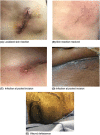Diagnosis and management of subcutaneous implantable cardioverter-defibrillator infections based on process mapping
- PMID: 32267974
- PMCID: PMC7607386
- DOI: 10.1111/pace.13902
Diagnosis and management of subcutaneous implantable cardioverter-defibrillator infections based on process mapping
Abstract
Background: Infection is a well-recognized complication of cardiovascular implantable electronic device (CIED) implantation, including the more recently available subcutaneous implantable cardioverter-defibrillator (S-ICD). Although the AHA/ACC/HRS guidelines include recommendations for S-ICD use, currently there are no clinical trial data that address the diagnosis and management of S-ICD infections. Therefore, an expert panel was convened to develop consensus on these topics.
Methods: A process mapping methodology was used to achieve a primary goal - the development of consensus on the diagnosis and management of S-ICD infections. Two face-to-face meetings of panel experts were conducted to recommend useful information to clinicians in individual patient management of S-ICD infections.
Results: Panel consensus of a stepwise approach in the diagnosis and management was developed to provide guidance in individual patient management.
Conclusion: Achieving expert panel consensus by process mapping methodology in S-ICD infection diagnosis and management was attainable, and the results should be helpful in individual patient management.
Keywords: antibiotics; diagnosis; extraction; infection; mapping; subcutaneous implantable cardioverter-defibrillator.
© 2020 Wiley Periodicals LLC.
Figures


References
-
- Baddour LM, Cha YM, Wilson WR. Clinical practice. Infections of cardiovascular implantable electronic devices. N Engl J Med. 2012;367:842‐849. - PubMed
-
- DeSimone DC, Sohail MR. Infection Management. Card Electrophysiol Clin. 2018;10:601‐607. - PubMed
-
- Deshmukh A, Patel N, Noseworthy PA, et al. Trends in use and adverse outcomes associated with transvenous lead removal in the United States. Circulation. 2015;132:2363‐2371. - PubMed
-
- Greenspon AJ, Patel JD, Lau E, et al. 16‐year trends in the infection burden for pacemakers and implantable cardioverter‐defibrillators in the United States 1993 to 2008. J Am Coll Cardiol. 2011;58:1001‐1006. - PubMed
-
- Dai M, Cai C, Vaibhav V, et al. Trends of cardiovascular implantable electronic device infection in 3 decades: a population‐based study. JACC Clin Electrophysiol. 2019;5:1071‐1080. - PubMed
Publication types
MeSH terms
LinkOut - more resources
Full Text Sources
Medical

